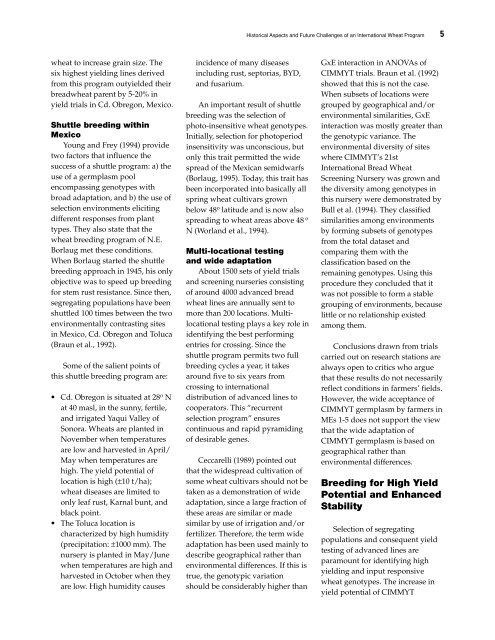Septoria and Stagonospora Diseases of Cereals - CIMMYT ...
Septoria and Stagonospora Diseases of Cereals - CIMMYT ...
Septoria and Stagonospora Diseases of Cereals - CIMMYT ...
You also want an ePaper? Increase the reach of your titles
YUMPU automatically turns print PDFs into web optimized ePapers that Google loves.
wheat to increase grain size. The<br />
six highest yielding lines derived<br />
from this program outyielded their<br />
breadwheat parent by 5-20% in<br />
yield trials in Cd. Obregon, Mexico.<br />
Shuttle breeding within<br />
Mexico<br />
Young <strong>and</strong> Frey (1994) provide<br />
two factors that influence the<br />
success <strong>of</strong> a shuttle program: a) the<br />
use <strong>of</strong> a germplasm pool<br />
encompassing genotypes with<br />
broad adaptation, <strong>and</strong> b) the use <strong>of</strong><br />
selection environments eliciting<br />
different responses from plant<br />
types. They also state that the<br />
wheat breeding program <strong>of</strong> N.E.<br />
Borlaug met these conditions.<br />
When Borlaug started the shuttle<br />
breeding approach in 1945, his only<br />
objective was to speed up breeding<br />
for stem rust resistance. Since then,<br />
segregating populations have been<br />
shuttled 100 times between the two<br />
environmentally contrasting sites<br />
in Mexico, Cd. Obregon <strong>and</strong> Toluca<br />
(Braun et al., 1992).<br />
Some <strong>of</strong> the salient points <strong>of</strong><br />
this shuttle breeding program are:<br />
• Cd. Obregon is situated at 28 o N<br />
at 40 masl, in the sunny, fertile,<br />
<strong>and</strong> irrigated Yaqui Valley <strong>of</strong><br />
Sonora. Wheats are planted in<br />
November when temperatures<br />
are low <strong>and</strong> harvested in April/<br />
May when temperatures are<br />
high. The yield potential <strong>of</strong><br />
location is high (±10 t/ha);<br />
wheat diseases are limited to<br />
only leaf rust, Karnal bunt, <strong>and</strong><br />
black point.<br />
• The Toluca location is<br />
characterized by high humidity<br />
(precipitation: ±1000 mm). The<br />
nursery is planted in May/June<br />
when temperatures are high <strong>and</strong><br />
harvested in October when they<br />
are low. High humidity causes<br />
Historical Aspects <strong>and</strong> Future Challenges <strong>of</strong> an International Wheat Program 5<br />
incidence <strong>of</strong> many diseases<br />
including rust, septorias, BYD,<br />
<strong>and</strong> fusarium.<br />
An important result <strong>of</strong> shuttle<br />
breeding was the selection <strong>of</strong><br />
photo-insensitive wheat genotypes.<br />
Initially, selection for photoperiod<br />
insensitivity was unconscious, but<br />
only this trait permitted the wide<br />
spread <strong>of</strong> the Mexican semidwarfs<br />
(Borlaug, 1995). Today, this trait has<br />
been incorporated into basically all<br />
spring wheat cultivars grown<br />
below 48 o latitude <strong>and</strong> is now also<br />
spreading to wheat areas above 48 o<br />
N (Worl<strong>and</strong> et al., 1994).<br />
Multi-locational testing<br />
<strong>and</strong> wide adaptation<br />
About 1500 sets <strong>of</strong> yield trials<br />
<strong>and</strong> screening nurseries consisting<br />
<strong>of</strong> around 4000 advanced bread<br />
wheat lines are annually sent to<br />
more than 200 locations. Multilocational<br />
testing plays a key role in<br />
identifying the best performing<br />
entries for crossing. Since the<br />
shuttle program permits two full<br />
breeding cycles a year, it takes<br />
around five to six years from<br />
crossing to international<br />
distribution <strong>of</strong> advanced lines to<br />
cooperators. This “recurrent<br />
selection program” ensures<br />
continuous <strong>and</strong> rapid pyramiding<br />
<strong>of</strong> desirable genes.<br />
Ceccarelli (1989) pointed out<br />
that the widespread cultivation <strong>of</strong><br />
some wheat cultivars should not be<br />
taken as a demonstration <strong>of</strong> wide<br />
adaptation, since a large fraction <strong>of</strong><br />
these areas are similar or made<br />
similar by use <strong>of</strong> irrigation <strong>and</strong>/or<br />
fertilizer. Therefore, the term wide<br />
adaptation has been used mainly to<br />
describe geographical rather than<br />
environmental differences. If this is<br />
true, the genotypic variation<br />
should be considerably higher than<br />
GxE interaction in ANOVAs <strong>of</strong><br />
<strong>CIMMYT</strong> trials. Braun et al. (1992)<br />
showed that this is not the case.<br />
When subsets <strong>of</strong> locations were<br />
grouped by geographical <strong>and</strong>/or<br />
environmental similarities, GxE<br />
interaction was mostly greater than<br />
the genotypic variance. The<br />
environmental diversity <strong>of</strong> sites<br />
where <strong>CIMMYT</strong>’s 21st<br />
International Bread Wheat<br />
Screening Nursery was grown <strong>and</strong><br />
the diversity among genotypes in<br />
this nursery were demonstrated by<br />
Bull et al. (1994). They classified<br />
similarities among environments<br />
by forming subsets <strong>of</strong> genotypes<br />
from the total dataset <strong>and</strong><br />
comparing them with the<br />
classification based on the<br />
remaining genotypes. Using this<br />
procedure they concluded that it<br />
was not possible to form a stable<br />
grouping <strong>of</strong> environments, because<br />
little or no relationship existed<br />
among them.<br />
Conclusions drawn from trials<br />
carried out on research stations are<br />
always open to critics who argue<br />
that these results do not necessarily<br />
reflect conditions in farmers’ fields.<br />
However, the wide acceptance <strong>of</strong><br />
<strong>CIMMYT</strong> germplasm by farmers in<br />
MEs 1-5 does not support the view<br />
that the wide adaptation <strong>of</strong><br />
<strong>CIMMYT</strong> germplasm is based on<br />
geographical rather than<br />
environmental differences.<br />
Breeding for High Yield<br />
Potential <strong>and</strong> Enhanced<br />
Stability<br />
Selection <strong>of</strong> segregating<br />
populations <strong>and</strong> consequent yield<br />
testing <strong>of</strong> advanced lines are<br />
paramount for identifying high<br />
yielding <strong>and</strong> input responsive<br />
wheat genotypes. The increase in<br />
yield potential <strong>of</strong> <strong>CIMMYT</strong>









